The Deep South Says ‘Never’
This is the fourth installment in our six-part series, “The Long March on Washington.” In part one, “It’s Our Country, Too,” we looked at the limited wartime opportunities for black Americans in the 1940s. In part two, “Black Neighbors, White Neighborhoods,” we covered integration in neighborhoods throughout the 1950s. In part three, “Black Students, White School,” we reported on integration in the classroom.
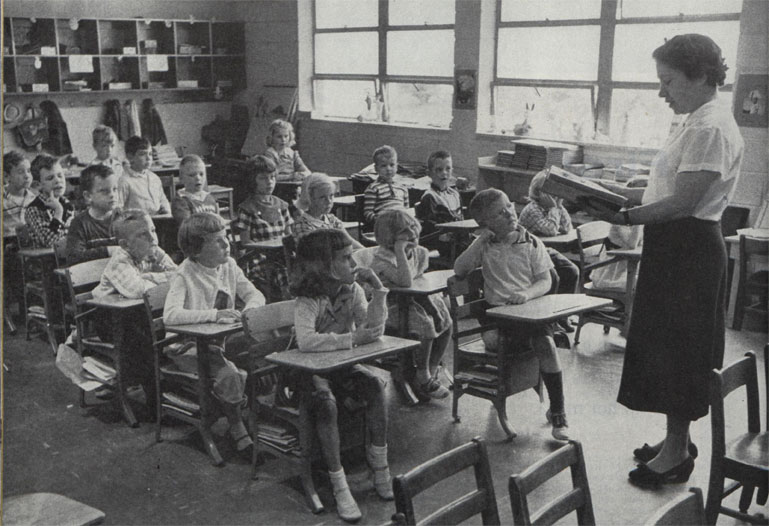
“With all deliberate speed” was how the Supreme Court wanted American schools to integrate their classrooms. But in the years following their Brown v. Board of Education decision, little action had been seen.
By 1957, about 330,000 black children had been admitted to formerly all-white schools, but another 2,475,000 still awaited integration.
The Post looked into the reasons for such little progress in a five-part series, “The Deep South Says Never” by John Bartlow Martin (June-July 1957), which it proudly called “the most exhaustive and penetrating look at the problems of integration yet published in an American periodical.”
The Supreme Court’s decision had outraged many Americans in Southern states with segregated schools. Southern politicians spoke of protests, legal appeals, and outright refusal to comply. But there was yet no organized effort to oppose the federal mandate.
Then, one night in 1953, Robert Patterson, a farmer in Indianola, Mississippi, attended a meeting at his children’s school where he heard officials announce their all-white school would have to admit black students. Patterson was stunned. As he later wrote in a widely distributed letter to “fellow Americans,” “I gathered my children and promised them that they would never have to go to school with children of other races against their will.”
He began seeking like-minded citizens who could build public opposition to the federal order. When he and a handful of associates called a town meeting to address integration, he told Martin, “Everybody of any standing was there.” They agreed to form the Indianola Citizens’ Council, which started a movement that swept across the South to solidify resistance to integration.
At first, the Council aroused little interest among Southern segregationists because the federal government did not try to enforce integration. During this time, Patterson and his friends traveled to other towns, speaking to the towns’ service clubs of the need to organize opposition to integration. Soon, Citizens’ Councils were springing up in adjoining states.
The Councils didn’t content themselves with merely building public support for segregation. They were ready to apply financial influence to silence the voices for integration. As a council member told Martin, “The white population in this county controls the money. … We intend to make it difficult, if not impossible, for any Negro who advocates desegregation to find and hold a job, get credit, or renew a mortgage.”
The Council began applying its influence in June 1955, when black residents in five Mississippi cities petitioned local school boards to admit their children to all-white schools.
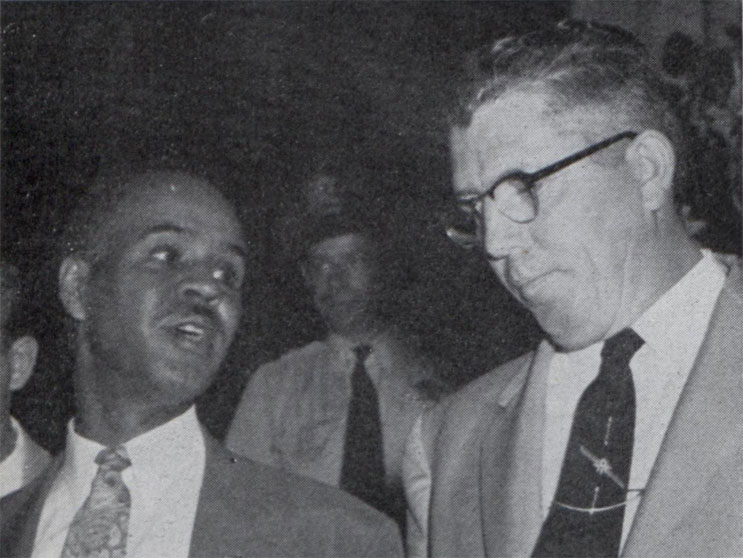
In Yazoo City, Mississippi, for instance, the Citizens’ Council published the names and addresses of all petitioners in the local paper. Roy Wilkins of the NAACP told Martin, “There were about fifty-three signers originally, and when [the Council] got through, only two signatures remained on it. One of them is living by helping his wife sell mail-order cosmetics—couldn’t get any work in town. One man had been a plumber for twenty years in Yazoo City, but he lost his business as soon as his name was in the paper.
“Wholesalers refused to supply a Negro grocer who had signed the petition, and a banker told him to come and get his money. He took his name off the petition, but it did no good. He left town.”
News that the petitions in all five cities were withdrawn encouraged the growth of segregationist groups in other states. By the end of 1955, one survey showed at least 568 local pro-segregation organizations in the South, claiming a membership of 208,000.
Council members were motivated by several reasons, though none admitted racism was among them. Some believed segregation was necessary to keep black men away from white women. (Patterson wrote protectively of “the loveliest and the purest of God’s creatures, the nearest thing to an angelic being that treads this terrestrial ball is a well-bred, cultured Southern white woman or her blue-eyed, golden-haired little girl.”)
Not all southerners supported these extremists. One Southerner told Martin he thought Council members were unintelligent and obsessed with interracial sex. “I once asked a council member, ‘What is your organization’s program?’
“He said, ‘To make people aware of the problem.’
“‘Do you think there is anybody south of the Mason-Dixon’s line that isn’t aware of it?’
“‘No.’
“‘Then what do you do at your meetings?’
“‘Well, we discuss the situation, discuss segregation.’
“‘It must get a little boring.’
“‘Well, yes, but we always get around to miscegenation.’”
Council members also felt they were fighting communism by opposing civil rights for blacks. Integration, they said, was a communist plot to stir up resentment in black Americans, who would rise up to destroy society. Patterson wrote, “If every southerner who feels as I do, and they are in the vast majority, will make this vow (to prevent integration), we will defeat this communistic disease that is being thrust upon us.”
What Patterson couldn’t have known was that the revival of aggressive bigotry in the South was helping to ignite a force in the black community. Black Americans were no longer waiting for the federal government to secure their civil rights, but had started taking action themselves.
Coming Next: The Rise of the Black Activists
Black Students, White Schools
This is the third installment in our six-part series, “The Long March on Washington.” In part one, “It’s Our Country, Too,” we looked at the limited wartime opportunities for black Americans in the 1940s. In part two, “Black Neighbors, White Neighborhoods,” we covered integration in neighborhoods throughout the 1950s.
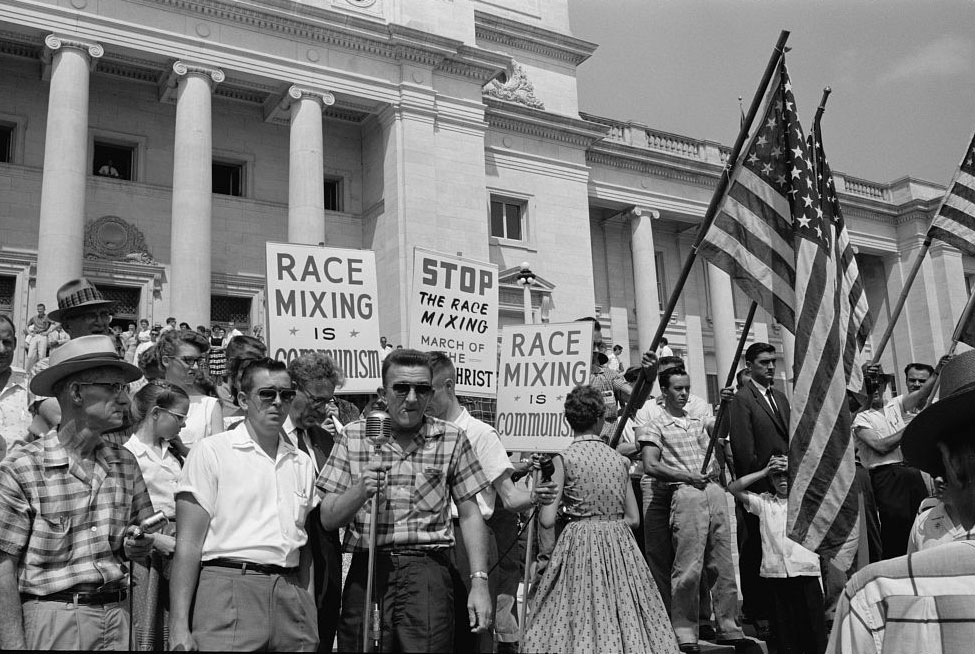
Black Americans might have hoped that the Supreme Court’s 1954 ruling in Brown v. Board of Education signaled the end of segregated schooling. But they soon learned not to hope for so much. Many states delayed or simply ignored the court’s order for “prompt and reasonable” integration of black students into white schools.
State defiance of federal law erupted in a bitter confrontation in 1957, at Little Rock, Arkansas. Seeking to comply with the Supreme Court, Little Rock’s school board developed a plan to integrate its all-white Central High School.
Unfortunately, as the superintendent of Little Rock schools later wrote in the Post, the plans to integrate black students were violently derailed by a combination of “organized bigotry, economic pressures, and selfish political scheming.”
In the five-part series “The Untold Story of Little Rock” (May-June 1959), Superintendent Virgil T. Blossom told how Arkansas Gov. Orval Faubus withdrew his support for the integration plans after he felt pressure from the state’s segregationists. By the time the school year had begun in September of 1957, Faubus was obstructing any attempt to introduce black students to white schools, which only encouraged the racists’ hopes of turning back integration. They redoubled their efforts, demanding further concessions from the school board as well as threatening violence against its members and their families.
Into this volatile situation stepped nine black students who bravely volunteered to enroll at Central, knowing the hostile reception that awaited them.
When Faubus heard of their intention, he ordered the state’s National Guard to keep black students off the school’s property. On the morning of September 4, wrote Superintendant Blossom, the first of these students, Elizabeth Eckford, approached the school, walking directly up to the line of guardsmen who closed ranks to block her way. She turned around, walked down the block and approached the line of guardsmen once more. “Again the guardsmen lining the sidewalk pressed together to block her path and she swerved to walk steadily down the line of troops, seeking an opening to the school grounds. She found none.”
At this point, a group of about 200 white adults saw her. They ran to block her path, surrounding her and screaming abuse and threats. The police and guardsman simply looked on impassively. “Trembling, but never losing her dignity, the Negro girl made a third vain effort to walk through the line of soldiers,” Blossom wrote. Realizing she couldn’t enter the school, she walked to a bus stop and silently waited while the crowd followed her pouring out insults and threats. When the bus came, she climbed aboard.
The Guard continued to keep black students out of Central High while a noisy mob surrounded the school shouting their defiance of integration, breaking into choruses of “Dixie,” and waving rebel flags. Then, on September 24, President Dwight Eisenhower decided he’d seen enough defiance of federal authority. He ordered the Army’s 101st Airborne Division to the city to replace the National Guard.
Each day for the next eight months, paratroopers escorted black students as they approached and left the school. At times, they even accompanied them in the school halls between classes. They regularly conducted school-wide bomb searches twice a day, and they kept the protestors in the street from slipping into the building.
Before the month was over, all nine black students had been admitted to Central and were attending classes, though continually taunted, threatened, shoved, and spat upon by white classmates.
The confrontation at Little Rock was the big story in the fall of 1957, both nationally and internationally. Blossom wrote, “A young American mountain climber at Gilgit, in Northwest Kashmir, reported there was ‘news about the Little Rock trouble on virtually every page’ of the newspapers and people repeatedly asked him whether ‘the United States really practices democracy as it tells us.’ Photographs and newspaper stories appeared on the front pages in virtually every city in Europe.” The Communist papers played up the story as much as possible, Blossom continued.
In his articles, Blossom was honest enough to admit he, personally, didn’t like the idea of integration. Yet, as school superintendant, he was determined to enforce the Supreme Court’s order, despite the opposition of Faubus and the threats from racists.
The Army continued enforcing integration until the school year ended in May. Before the next school year could begin, Faubus secured his support from Arkansas’ segregationists by ordering all four high schools in Little Rock to be closed.
Concluding his series of articles, Blossom felt the blame for Little Rock’s troubles shouldn’t have been placed solely on the opponents of integration: the demagogues, white supremacists, Klansmen, racist students, and freelance thugs that swarmed around the school. He believed the federal government was also responsible for the problems because it had enforced integration with the military. He agreed with a southern congressman who told him, “when the President sent the Army’s toughest troops with bayonets on their guns against unarmed white citizens, he made a mistake we will never forgive.” Like many of his contemporaries, he believed integration would only be achieved peacefully, slowly, and reasonably.
The federal government, it appeared, had no overall plan for protecting its black citizens’ civil rights. Meanwhile, segregationists were organizing their efforts to stall integration
Coming Next: “The Deep South Says, ‘Never.’”
The Kennedy-Wallace Showdown on Integration
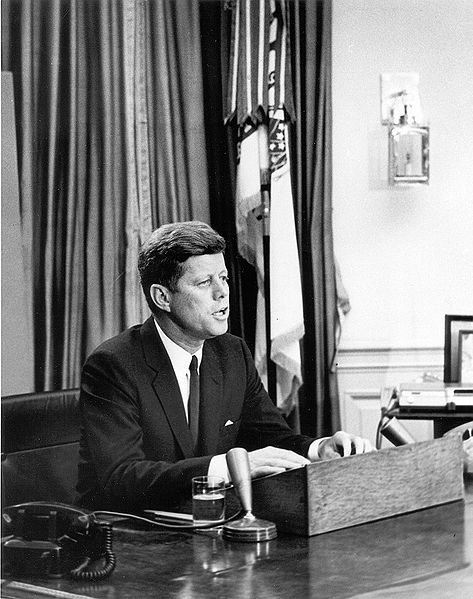
All baby boomers can tell you exactly where they were and what they were doing on November 22, 1963. The murder of John F. Kennedy was a defining moment of their childhood, just as Pearl Harbor was for the preceding generation, and 9/11 was for the millennials.
A half-century of books and movies related to the assassination have made that afternoon in Dallas the most frequently recalled event of 1963. Unfortunately, its prominence in public memory overshadows other events that eventually shaped our lives far more than the death of the president.
Black Americans’ fight for equal rights had become hard to ignore in 1963. It had broadened from the 1957 confrontation at Little Rock Central High School where federal troops had enforced the right of black students to attend a previously all-white high school. And this action had arisen from the Supreme Court’s decision in 1954, outlawing segregated schooling, which would separate children into all-white or decidedly inferior all-black schools.
A Post editorial in February 1963 (“Bad words and good words down South”) observed the varying responses to black protest and legal challenges among southern states. In Alabama, they noted, there was no talk of compromise or acceptance. George Wallace, then governor of Alabama, had chosen to be sworn into office standing precisely where Jefferson Davis stood when he was sworn as the Confederacy’s first president. “As far as Wallace was concerned,” Post editors wrote, “the interval since Jeff Davis might just as well not have occurred. ‘I draw the line in the dust and toss the gauntlet before the feet of tyranny,’ Gov. Wallace said. ‘I say segregation now, segregation tomorrow, segregation forever.’”
In contrast, the governors of South and North Carolina were talking of life beyond segregation.
In South Carolina, the new governor announced he would pursue “a sensible approach” to racial problems, which the state would work out “according to our standards of justice and decency.” In North Carolina, Gov. Terry Sanford had told the press, “The time has come to quit unfair discrimination and to give the Negro a full chance to earn a decent living for his family and to contribute to higher standards for himself and all men.”
These were reassuring words for white Americans who wanted to believe state governments would finally start implementing the end of “separate but equal” schools.
However, Carl T. Rowan wasn’t reassured. The journalist, then working with the secretary of state on public affairs, had seen little change in the nine years since the Brown v. Board of Education decision. Writing “The Travesty of Integration” (January 19, 1963) for the Post, he argued that what little change had taken place was, in fact, a carefully built illusion of progress. “Scores of communities have, by devious means, pretended to comply with the letter of the law while ignoring the spirit of justice and decency that the law embodies.”
Of North Carolina’s 173 school districts, only 16 had ended segregated schooling. “In those 16 supposedly integrated districts last year, only 901 Negro children were in school with white youngsters. The other 77,404 colored pupils … were still in all-Negro schools.”
Rowan also referred to Prince Edward County, Virginia, where, in 1959, the board of supervisors withdrew all funding from the public schools rather than comply with an integration order. For the next five years, all schools in the county remained closed—except for private, foundation-operated schools that admitted only white children.
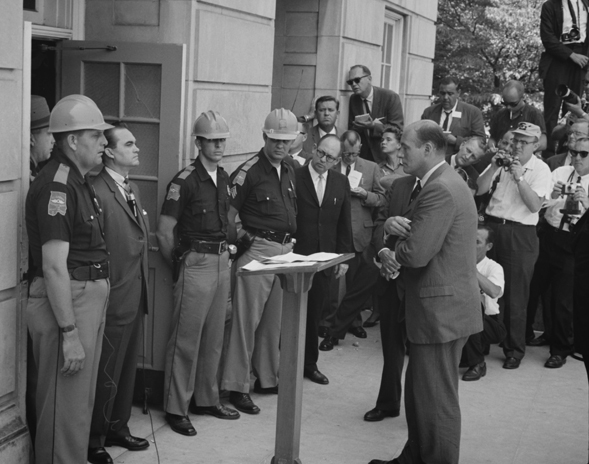
“In Texas, they may boast about the ‘peaceful transition’ to ‘integration’ in Dallas or Houston,” Rowan added, “but the meaningful thing to me is that a ‘whopping’ 2.16 percent of the Negro children in that state attended integrated schools last year.”
Even where integration had begun, administrators were suggesting policies that only reinforced racial stereotypes.
“In Little Rock, some ‘moderates’ argued at first that all the Negroes in the first group to be admitted to white schools ought to be light-skinned. In other communities there have been demands that all Negroes in the token delegation be girls—so as to preclude the ‘wrong kind’ of interracial romances.”
Rowan couldn’t understand why the federal government could enforce its tax laws so effectively but prove so ineffectual in guaranteeing civil rights for all its citizens. He believed Americans would either have to push their government to enforce the laws or live with the change that came in response to sit-ins, demonstrations, possible violence, and near anarchy.
Wallace believed there was a third choice, which was to stubbornly resist all change. On June 11, 50 years ago, he stood in the doorway of Foster Auditorium at the University of Alabama. In an event staged for the media, he refused to step aside and allow Vivian Malone Jones and James Hood, two black students, to enter and register for enrollment. The U.S. deputy attorney told Wallace to move. Wallace refused and launched into a speech about states’ rights. The deputy attorney phoned the White House. In response, President Kennedy ordered the National Guard to clear the doorway. Wallace moved out of the way.
Later that same day, the president addressed the nation to announce that the federal government would finally undertake a legislative initiative to ensure civil rights. Kennedy asked for legislation to outlaw racial discrimination and segregation, ensure voting rights, and guarantee equal protection under the law for all citizens. His proposal was realized in the Civil Rights Act, which was eventually signed into law by Lyndon Johnson in 1964.
After hearing the news from Alabama and Washington, Americans might have gone to bed that night with a sense that, finally, the country was seeing the end of the protests, anger, and violence in the fight for civil rights.
The next day, June 12, civil rights activist Medgar Evers was shot in the back and killed as he returned home from a meeting with NAACP lawyers. His killer was Byron De La Beckwith, a member of the White Citizens’ Council, who eluded punishment for 21 years. The fight was far, far from over.